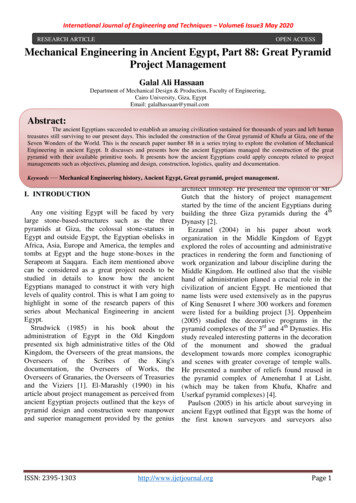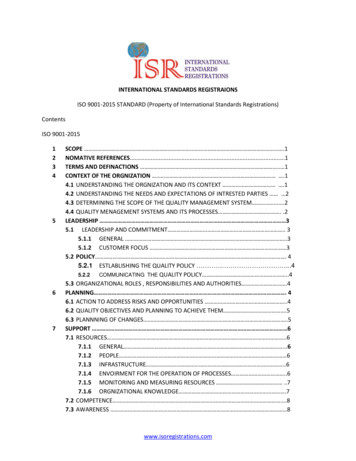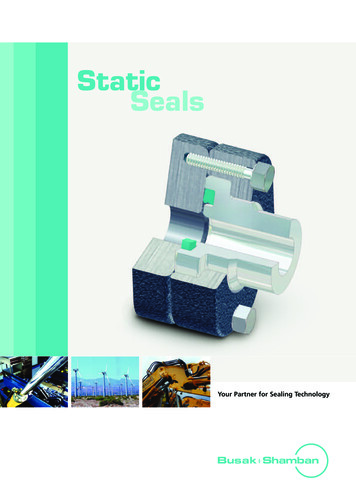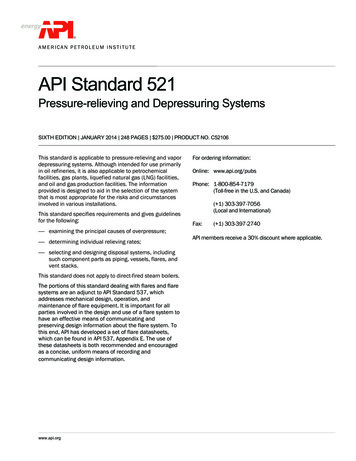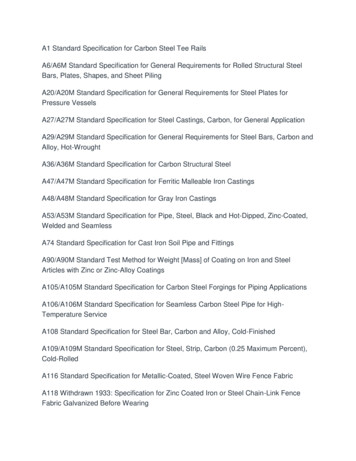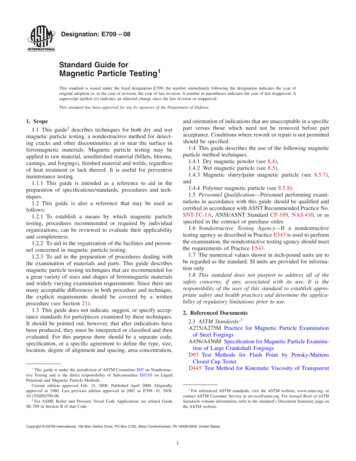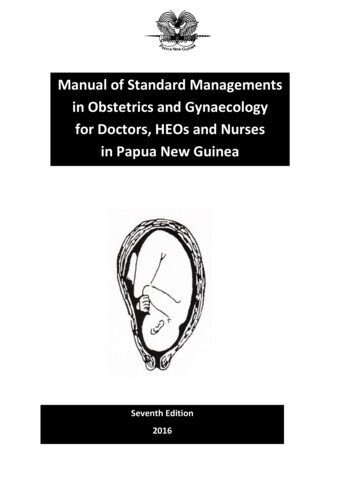
Transcription
Manual of Standard Managementsin Obstetrics and Gynaecologyfor Doctors, HEOs and Nursesin Papua New GuineaSeventh Edition2016
TALK TO THE MOTHER- Always tell her about her problem and its management.- Tell her about healthy diet and safe sex.- Discuss family planning with her & the importance of breastfeeding.- Tell her to bring her record book/clinic card whenever shecomes for antenatal care or attends OPD for an illness.FAMILY PLANNING (See page 62 of this manual) Every woman and couple need to use family planning Some women can rely on abstinence to avoid getting pregnant;however, most require assistance to select other methods. When women have had sufficient children or when they reach para 3,they should be offered tubal ligation so as to avoid the dangerousproblems of becoming a grand multipara. Some women or couplesmay request tubal ligation or vasectomy when they have fewer than 3children. Family planning is about making sure that the mother, children andfather are in good health and well-being. A good and strong family ispromoted when: The total number of children is fewer than 5 The spacing of children is more than 2 years Mother’s age is 20 and 35 years. Parents have a regular source of money & other resources All children complete their education. Children are well trained and disciplined by loving and caringparents.
Manual of Standard Managementsin Obstetrics and Gynaecologyfor Doctors, HEOs and Nursesin Papua New GuineaSeventh Edition2016Editor: Glen DL Mola MB.BS.DPH. MRACGP, FRANZCOG.FRCOG. OL, CSMProfessor of Obstetrics & GynaecologySchool of Medicine and Health Sciences, UPNG
ContentsINTRODUCTIONIPREFACE TO THE SEVENTH EDITIONIIPREFACE TO THE FIRST EDITIONIIIABBREVIATIONSIVDEFINITIONSVIDOS AND DON’TSVIIABORTION OR MISCARRIAGE1ANAEMIA IN PREGNANCY5ANTENATAL CARE8ANTE-PARTUM HAEMORRHAGE (A.P.H)14AUGMENTATION (OR ACCELERATION) OF LABOR19BREAST FEEDING & INDUCTION OF LACTATION23BREECH27CAESAREAN SECTION31CANCER OF THE CERVIX & MANAGEMENT OF CHRONIC PAIN37DELIVERY (INCL. ACTIVE MANAGEMENT OF THE THIRD STAGE)42DIABETES IN PREGNANCY47DYSFUNCTIONAL UTERINE BLEEDING (D.U.B)52ECLAMPSIA56ECTOPIC PREGNANCY60FAMILY PLANNING METHODS62FETAL DEATH IN UTERO71HIV IN PREGNANCY INCLUDING PPTCT73INDUCTION OF LABOR80INFERTILITY84LABOR MONITORING AND USE OF THE PARTOGRAPH86MALARIA IN PREGANCY: PREVENTION AND TREATMENT94MASSES (LOWER ABDOMINAL)97MATERNAL MORTALITY REGISTER REPORTING FORM99
MOLAR PREGNANCY, (HYDATIDIFORM MOLE) AND CHORIOCARCINOMA101NEONATAL CARE104OBSTRUCTED LABOR AND DESTRUCTIVE DELIVERY109PELVIC INFLAMMATORY DISEASE (PID)112POST-NATAL CARE OF THE MOTHER118POST PARTUM HAEMORRHAGE121PRE-ECLAMPSIA (PET)126PRETERM LABOR & PRELABOR RUPTURE OF THE MEMBRANES130PROLAPSED CORD134PROLONGED PREGNANCY (POSTMATURITY/POST-TERM)135PUERPERAL FEVER138RAPE AND SEXUAL ASSAULT141REFERRAL: CRITERIA, WHEN AND HOW TO DO IT147RETAINED PLACENTA & MANUAL REMOVAL149SECONDARY SUTURE152SHOULDER DYSTOCIA153SYMPHYSIOTOMY154TEARS OF PERINEUM (INCLUDING 3RD & 4TH DEGREE)159TRANSVERSE, OBLIQUE AND UNSTABLE LIE161TWINS162VACUUM EXTRACTION165VAGINITIS AND VAGINAL DISCHARGE170VULVAR LESIONS172APPENDIX A176INDEX.178EMERGENCY ADVICE AND ASSISTANCE184
INTRODUCTIONBooks on Standard Treatments are of utmost importance to ourhealth workers and people for they ensure the most efficient andbest possible medical service for our country.Standard treatment regimens should be used in all cases unlessthere are specific professional reasons to do otherwise. Themedical supply system as well as health worker trainingprogrammes are all linked.To write such books requires considerable skill, insight into localproblems and disease patterns, and effort. The HealthDepartment thanks Professor Glen Mola and other members ofthe Papua New Guinea Society of Obstetrics and Gynaecology;the Department of Health is most grateful for their energy in doingthis important task.The review working group for the 7th edition comprised Drs GlenMola, AB Amoa, Mary Bagita, Ligo Augerea, Lahui Geita, MiriamO’Connor, other senior Obstetricians and members of the O&Gand Midwifery Societies of PNG. The input of the World HealthOrganisation is also acknowledged.Obstetrics and Gynaecology has been a leader in the field ofmedical and public health audit and I am pleased to see thatpublic health and audit issues are emphasized in this updatedO&G Standard Treatment Manual. This book should be seen ascomplementary to those in the other major medical disciplines ofPaediatrics, Medicine, Surgery and Anaesthesia.Mr. Pascoe KaseSecretary for HealthCover design by: John Gras Atepi
PREFACE TO THE SEVENTH EDITIONThere are many new protocols in this 7th edition of the O&G StandardTreatment Manual - e.g. relating to the use of Misoprostol in thetreatment of miscarriage and PPH. When you get your new edition ofthe STM please discard the previous editions and follow this one.Since writing the first edition of this manual in 1986, there have beenmany developments in Obstetrics & Gynaecology in Papua NewGuinea. We have a new National Health Plan 2010-2020. Fivemidwifery schools in the country have been set up, and since 2011 500new midwives have been trained. The School of Medicine and HealthSciences (UPNG) now graduates up to 55 new doctors annually andthere are now doctors in many of the nation’s major health centres anddistrict hospitals. In addition, a specialist training program in ruralmedical practice has been established, and 20 new obstetriciangynaecologists have passed out of the MMed training program at theSMHS.Ultrasound is available in most provinces, and doctors with widerobstetric experience are available in most provincial hospitals. On theother hand our radiotherapy unit (at the National Cancer centre situatedat Angau hospital, and only refurbished and reopened in 2009) is stillnot able to provide the brachytherapy that is necessary to properly treatthe commonest women’s cancer, cervical cancer.The seventh edition of the manual contains many suggestions whichhave originated from members of the Papua New Guinea Society ofObstetrics and Gynaecology and Society of Midwives, and fromexperienced health workers working throughout the country. Should anymembers of the health team have any suggestions which they feelwould make the manual more useful, please write to the Editor at PortMoresby General Hospital. It is planned that a new edition of the bookwill be published every five years.The review and printing of the O&G Standard Treatment pocket book hasbeen assisted by the National Department of Health and WHO.Professor Glen Mola School of Medicine & Health Sciences, UPNGii
PREFACE TO THE FIRST EDITIONPapua New Guinea has been a world leader in establishing standardmanagement manuals for health workers. The standard managementbooks in paediatrics and adult medicine have been in use for many years:they have undoubtedly been instrumental in producing more effectivemanagement of patients in those areas.This standard management manual in obstetrics and gynaecology hasbeen produced by a committee of the Papua New Guinea Society ofObstetrics and Gynaecology comprising Dr Glen Mola, Dr Ed Miller andProfessor Jill Everett. It was presented to the general meeting of theSociety for comment in September 1986 and modified in the light ofvarious comments and suggestions. Any further comments should besent to Dr Glen Mola at Port Moresby General Hospital.The management regimens in this book are simple and effective. It isrecognised however, that sometimes doctors treating certain patients willuse alternative management to those prescribed in this book. In thesecircumstances it is a good idea to make it clear to junior medical, nursingand para medical staff the reasons for varying standard treatment.Glen MolaPresident PNG Society of Obstetrics & GynaecologyDecember 1986iii
DIMIAcquired Immunodeficiency SyndromeAntenatal Clinic/cardAntepartum HaemorrhageArtificial Rupture of MembraneAntiretroviral drugsZidovudine (an antiretroviral drug)Born before arrivaltwice dailyBlood slide (for malaria parasite examination)Cervical intraepithelial neoplasia (a precursor tocancer of the cervix picked up on Pap smear)Cephalo pelvic disproportionCaesarean Section: if low uterine segment, (L.S.C.S)or classical C.S.CervixDisseminated Intravascular Coagulation.drops per minuteDysfunctional Uterine BleedingDextrose 4.3% and Normal SalineExternal Cephalic VersionEstimated Date of DeliveryEstimated Gestational Age - calculated from the EDDExamination under AnaesthesiaFamily PlanningNumber of centimetres from the pubic bone to theupper point of the fundus.Glucose Tolerance TestGeneral AnaestheticHuman Immunodeficiency virusIndwelling catheterIncision and drainage (of abscess)Intra-muscular injectioniv
PTPVqidSTD/STISRMSCNTAHtdsTDITLVCTVDRLIntra uterine growth restrictionIntravenouslyLower abdominal painFirst day of last menstrual periodMagnesium sulphateManual Vacuum AspirationOral contraceptive pillProvider initiated counselling and testing (for HIV)Post-Partum Haemorrhage - measured blood lossgreater than 500mlPost exposure prophylaxis (anti-retroviral drugs givento those who have been exposed to HIV – eg. rapevictims and needle stick injury cases)Pre-eclampsiaPelvic Inflammatory DiseasePre-menstrual Syndromeas requiredPrevention of parent to child transmission (of HIV)Pregnancy testper vaginum (from or into the vagina)6 hourlySexually Transmitted Disease/InfectionSpontaneous Rupture of the membranesSpecial care nurseryTotal Abdominal Hysterectomy8 hourlyTotal Dose ImferonTubal LigationVoluntary counselling and testing (for HIV)Blood test for Syphilis; nowadays usually done by RDTv
DEFINITIONSGravidity (G):Total number of pregnancies.Parity (P):Number of prior deliveries with delivery ofbabies more than 22 weeks gestation or over500g.Abortion (Ab):Delivery of an embryo of fetus weighing lessthan 500gStillborn (SB):Baby born without a heartbeat and weighingover 500g.Perinatal Mortality (PNM): Stillborns plus early neonatal deaths(first week of life) per 1000 births. The national perinatal mortalityrate (PMR) for PNG calculated from the 2006 DHS was about50/1000 births. With good quality antenatal and intrapartum carethis should be reduced to around 20/1000.Neonatal death (NND): Death of a baby within first 28 days ofbirth. Early NND is infant death during first week of life (7days).Maternal Mortality (MM): Death of a woman whilst pregnant orwithin 42 days of delivery or termination of pregnancy, from anycause related to or aggravated by pregnancy or its management,but excluding deaths from incidental or accidental cause.Low Birth Weight (LBW): birth weight less than 2500g.Very Low Birth Weight (VLBW): birth weight less than 1500g.Extremely Low Birth Weight (ELBW):less than 1000g.vi
DOs and DON’TsDOs1. DO counsel ALL women about family planning, especiallywhen they bring their young children to the baby clinic.2. DO book EVERY woman who comes to the Antenatal Cliniceven if they are in the first trimester: this is the best time to getthe dates right and treat infections and anaemia.3. When a woman arrives with labor pains and she is less than4cm dilated. DO start her on the partogram; don’t wait until sheis 4cm to begin the partogram.4. DO keep all your oxytocin and ergometrine in the vaccinefridge. DON'T say the vaccine fridge is only for vaccines.Don’t lock up the Misoprostol in a cupboard; it needs to beavailable to all staff at all times to treat emergency cases.5. DO a vaginal and speculum examination on all women whopresent with gynaecological symptomsDON’TS6. DON'T tell women to stop family planning when they get sickor have symptoms. They should continue family planning andbe referred to a doctor if you can’t work out their problem.7. DON'T send women away from the FP clinic if they have nokids, or are very young, or it is not the day you usually dofamily planning clinics. Family planning must be available forevery person every day in every facility, and in every part ofthe hospital including wards and outpatients.8. DON'T say to women in the antenatal clinic that everything is‘fine’ or ‘normal’, and they are low risk therefore they candeliver at home: all women must come for a supervised birth.9. DON'T give antibiotics to all women coming to deliver.10. DON'T leave women in labour alone at any time.11. DON'T send women home straight after birth; encouragethem to stay in the health centre for at least 2 days post-partum tolearn more about family planning, postpartum and infant care.vii
ABORTION or MISCARRIAGEIf a sexually active woman who is not using any FP, and whousually has regular periods then has a period of amenorrhoeafollowed by variable amounts of PV bleeding /- lowerabdominal colicky pain, the most likely diagnosis is some kindof miscarriage.Decide if the miscarriage is threatened, incomplete, septic, ora mole (page 101), and consider the differential diagnoses ofectopic (page 60) or DUB (page 52). Bleeding from apregnancy before 20 weeks is classified as a miscarriage,after 20 weeks as an APH (page 14).Always inquire whether any pregnancy was planned or not(ie. ‘a mistake’): this information will assist you to giveappropriate Family Planning advice to the woman.Threatened Miscarriageis diagnosed if there is little bleeding and little or no pain; thecervical os is closed, and the size of the uterus correspondsto the dates. Check the cervix and vagina with a speculum tomake sure that there is no cervical lesion or infectionaccounting for the small PV bleeding (eg. cervical and vaginalcauses for PV bleeding, like polyp/cancer).Managementa. Advise the patient for possible progression to incompletemiscarriage, ie. increasing bleeding, pain etc. (seebelow): therefore come back if the bleeding gets worse.b. An ultrasound examination (if available) can be helpful ifit detects a live, intra-uterine pregnancy. If a pregnancy isseen in the uterus and there is no fetal heart movement(Missed Abortion) or no fetus at all is seen in a relativelynormal pregnancy sac (Blighted Ovum) she will go on tomiscarry soon. In these circumstances it is better toevacuate the uterus either by insertion of vaginal1
misoprostol 4 tabs or D&C. A molar pregnancy can alsobe seen on ultrasound. If there is NO pregnancy sacseen in the uterus she may: Have an ectopic (page 60); (consider urine PT andculdocentesis), Not be pregnant; (check urine PT), Be less than 6 weeks pregnant; (review the scan againin 1-2 weeks).Incomplete MiscarriageDiagnosed if there is heavy bleeding associated with crampinglabor like lower abdominal pains and the cervix is softened andopen (admits a finger or more), or tissue (fetus or membrane) ispassed. However, pieces of pregnancy tissue are sometimesindistinguishable from a decidual cast (which is sometimespassed when there is an ectopic pregnancy) and hyperplasticendometrium which can be passed when there is DUB (see p52).Management1. If the patient is shocked resuscitate with IV N/Saline (orHartmans solution)2. Give ergometrine 0.25mg IM or IV. Not oxytocin.3. Quickly remove products of conception from the cervicalos with sponge forceps: do NOT wait to get to theatre todo this. She will not stop bleeding if there is tissue stuckin the cervix.4. In the health centre, evacuate (‘clean out’) the uteruseither by inserting misoprostol 4 tabs into the rectum orhigh up into the vagina: in most cases this will evacuatethe uterus in 24-48 hours. In the hospital setting allincomplete miscarriages should be evacuated as soon aspossible: this can be done by MVA, insertion of vaginalmisoprostol 4 tabs, or sharp curettage. This preventsblood loss and the possibility of infection getting in tocause septic abortion.2
5. Analgesia for evacuation by sharp curettage: sedation withpethidine diazepam or Ketamine anaesthesia can be used.If evacuation is to be effected by insertion of vaginalmisoprostol or MVA no anaethesia is necessary. (Sendcurettings for histology if there is any doubt about thediagnosis, ie. you think it might be DUB or Hydatidiform moleand not a miscarriage, see NB* below).Paracervical block techniqueIf the cervix needs to be dilated for D&C (for diagnostic D&Cfor DUB/Cancer of the endometrium, or evacuation of aMissed Abortion etc.) good analgesia can be obtained byusing a paracervical block. Inject 2-3ml of 1% lignocainewhere the cervix joins to the vaginal vault at 2, 4, 8 and 10o'clock positions. The injection should be quite shallow, - ie.only 5mm deep. In more advanced gestations paracervicalblock should be performed using a modified technique, - see Retained Placenta' page148.(NB*: Occasionally an episode of dysfunctional uterinebleeding (DUB) is diagnosed as an abortion because of thehistory of amenorrhoea followed by a heavy painful period.The proper diagnosis may be apparent if a careful menstrualhistory for the past year is taken. DUB patients often haveirregular periods: at D&C the cervix will be closed and firm, ie.not admit a Hegar 8 dilator without resistance. Also thepregnancy test will be negative).Septic MiscarriageA diagnosis is made if there is an incomplete miscarriageassociated with: Evidence of sepsis (fever, fast pulse, offensive PVdischarge, uterine tenderness and abdominal pain),3
If there is evidence of septic abortion you should alwaysconsider that there may have been interference with thepregnancy.The patient may be more shocked than the reported or seenamount of blood loss would suggest, and there may beinternal damage if sharp objects have been inserted.Treatment:1. Resuscitate with IV fluids and/or blood if the patient isshocked.2.Give ergometrine 0.25mg amp IV.3.Give triple antibiotics IV for at least 24-48hrs.Crystapen 1mega unit qid, or Amoxicillin 500-1000mgtds; and Gentamycin 5mg/Kg daily IV OR IVmetronidazole 500mg tds. Change to oral ABs after48hrs or fever has subsided: Amoxil 500mg tds Tinidazole 1g bd, or metronidazole 500mg tds. Continuegentamycin VI or IM for 3-5 days.4.Evacuate the uterus when the patient has beenresuscitated & antibiotics commenced: manual vacuumaspiration (MVA) or rectal misoprostol (insert 4 tabs) isbest for this.5.Consult an SMO if generalized peritonitis is present orthe woman is very sick. With septic miscarriage cases,transfer for transfusion if Hb is less than 8g%.Always assist miscarriage and abortion cases with Family Planningbefore they discharge: after a miscarriage, a woman should not tryand get pregnant again for at least 4-6 months. If she is pale, alsosupply Fefol sufficient for 1-2 months.4
ANAEMIA IN PREGNANCYAnaemia is the commonest medical problem associated withpregnancy in PNG, but this does not make it “normal”; itcontributes to many maternal deaths. Its cause is usuallymultifactorial (ie. many causes). On the coast the prevalenceof anaemia can be as high as 40-50% in women.Definition: Hb level less than 10g/dl, or when you do not haveaccess to a laboratory she appears very pale on clinicalexamination of the mucous membranes. (Always check the 4sites: palms, conjunctivae, lower lip and nail beds.)Anaemia Prophylaxis (for all antenatal patients)1. Ferrous sulphate (200mg) 1 tab daily and Folic acid 5mg (1tablet) weekly or Fefol 1 daily. If you give higher doses offerrous sulphate it often causes gastrointestinal side effects,eg. nausea, constipation, heart burn etc. (ferrous fumaratecontaining iron tabs cause less gastrointestinal side effects.)2. Give standard treatment for malaria in areas where there isprevalence of malaria (see page 94).Hb estimations should be done at booking: (repeat if thewoman becomes pale and one month later if she is anaemicat booking). If you are not able to do Hb tests, check forclinical signs of anaemia at every visitTreatment of established Anaemia (Hb less than 10g %)All should receive:1. Extra iron and folic acid, Fefol 1bd, or Folic acid 5mgdaily and Ferrous sulphate/fumarate 1 bd for several months.If the woman has healthy bone marrow she will be able tomake 1-2 grams of Hb per fortnight: therefore most anaemicwomen will need to take Fefol for at least 2-3 months.5
2.Albendazole 400mg stat. (4 tabs): if the woman uses aninside toilet Albendazole is probably not necessary, onlygive Albendazole after the 1st trimester3.A standard treatment course of malaria tablets: (Seenew schedule for malaria in pregnancy, page 96)4.If blood transfusion is required (see table below) onlyuse packed cells. Each unit should run slowly, ie. over 46 hours. Give IV Frusemide 20 mg before each unit.Fefol, Folic acid, Albendazole and standard treatment formalaria will need to be given after the blood. Only giveImferon if the woman is not able to take oral iron.5.Imferon (See table below for advice on iron in pregnancy*).There is no advantage in giving Imferon to patients if theyare able to take oral iron successfully. However, somewoman get very unpleasant gastrointestinal side effectsfrom oral ferrous sulphate (this is why ferrous fumarate isbetter), and some women are simply unable to rememberor capable of taking oral iron for long periods. Largedoses of iron can be given by 'total' dose Imferon (TDI).The dose should be 25ml for 60kg women and 30mlsfor women 60Kg. (These doses of Imferon are less thanthose recommended in the paper which comes with thedrug; however, it is better to give these smaller ie. partialdoses, as you can then follow up with oral supplementsof iron tabs as with all antenatals).Give 12.5mg of Promethazine IV when the infusion iscommenced. Use a test dose of 5mls in the flask ofNormal Saline and run in 200mls over a few minutes todetermine whether the patient is allergic to the drug. Ifnot add the remainder of the dose to the flask and run itin over 4 hours. Record TDI in the record book at ANC.6
Imferon can be given intramuscularly instead, but it is a verypainful injection and can cause skin discoloration at theinjection site in light skinned people. Do not give a second TDIwithin 12 months.Hbg% 36 weeksPregnant7-9Oral ferrous Sulphateor Fefol 1 tab bdTDI* or oral Fefol if thewoman is sure to befaithful with a dailydoseOral ferrousSulphate or Fefol1 bd for 1 month5-7Ferrous sulphate orFefol 1 tab bdTDI* and transfer toHospitalFefol 1bd for 2monthsStart treatment andtransfer to hospital.Transfusion ofpacked cells maybe necessaryGive TDI* andtransfer to hospitalFerrous sulphateor Fefol 1bd for 3months 5 36 weeksPregnantXmatch packed cellsand hold for deliverytimePostnatal6.Emphasize spacing the next child to give the mother achance to get strong again. Recommend FamilyPlanning for those wanting more babies later, and TL orvasectomy for those who don't.7.Give nutrition and diet education to the woman.Anaemia Post-Partum1. Give Iron and Folic acid tablets (Fefol) for 1-3 monthssupply to take home and Albendazole 2 tabs stat.2. Emphasize once again the importance of FP to space thenext pregnancy by at least 3 years, or to have TL (orvasectomy) if the couple have had sufficient children.7
ANTENATAL CAREAll women should be encouraged to book EARLY forantenatal care. It is best if they book when they have missed2–3 periods, but at least all women should be booked by thetime the baby starts moving (quickening). In this way it ispossible to get the dates right and to screen for disease(especially syphilis and HIV) and other problems beforethese cause any bad effects, and damage the pregnancy.Be alert to domestic violence in pregnancy: if you suspect it,ask specific pertinent questions.NEVER send a mother away if she comes to the clinic tobook. Even if the clinic is full or very busy, at least give heran antenatal card or ‘Mama buk’, record her dates and takeblood for tests, - then she can come back on a less busyday to complete booking and get her test results.In village clinics or other places where you may not haveany private place to examine antenatals you should stillbook antenatal mothers. The obstetric history picks up manyantenatal risk factors, and you can take blood for tests, giveTet. toxoid, counsel the mothers etc. even if there is noprivate examination room available.Normal patients may be seen by a health worker monthlyuntil 30 weeks, fortnightly until 38 weeks, then weekly todelivery. (In rural areas women must be seen whenever anMCH clinic takes place. Women with problems may need tobe seen more often, and completely normal women lessoften than the schedules given above.)GIVE THE WOMAN HER ANTENATAL CARD TO LOOK AFTERDo not keep the card in the clinic box. The mother needsher antenatal card available to her at all times, andespecially if she has a pregnancy problem or comes intolabor. You cannot be sure when or where she will have herbaby. This also encourages community and individualparticipation in their own medical care.8
Mothers have been looking after baby books for manyyears: they are perfectly capable of looking after their ownAN cards. It does not matter if the card gets a bit dirty ortorn. Mama record books are also available in mostprovinces.At the first visit:Ask the woman if this is a planned pregnancy, and if shehas been using any FP. It is important to know this if youwish to have a good talk with her about family spacing or TL.a) Carefully record the medical and obstetric history,including 1st day of LMP, and date of Quickening or thedate when she first felt fetal movements – how manyweeks or months ago.b) Perform a physical examination, especially checking forsigns of anaemia, abdominal scars, an enlarged spleen,fundal height in cms, size of uterus in gestation weeks(eg. 16/40), and loud heart murmurs. Record all theabove on the antenatal card. In some clinics a speculumexamination is done at the first visit to exclude cancer ofthe cervix. [Speculum examination in pregnancy requiresexpertise; there is more physiological mucous present inpregnancy and it is important not to think normal mucousis an abnormal vaginal discharge – and then giveunnecessary antibiotics.]GETTING THE EDD RIGHTWhen you ask a woman for her LMP, never write down thefirst thing she says. Always follow up with another questionlike, “did you see your period on that month or did you missit on that month?”If 1st day of LMP is certain her EDD is 40 weeks later ie. add7 days and 9 months to the 1st day of LMP EDD. If LMP isuncertain (or if the fundal height is more than 3cm from whatit should be, based on LMP), determine her EDD based onFunHt and quickening:9
At 12-13 weeks the uterus is just palpable above thesymphysis pubis At 16 weeks the fundus is half-way to the umbilicus At 20 weeks the fundus is just at the umbilicus After 20 weeks and up to about 35 weeks, the Fundal Htin cm equals the number of completed weeks (e.g. if theFundal Ht is 23cm, the estimated gestational age (EGA) is23 weeks and her EDD is 17 weeks later).A good check of the gestation is the onset of fetalmovements. Primigravidae usually begin to feel the babymove at 20 weeks and multips at 18 weeks; therefore onecan add on 20 or 22 weeks (ie. about 5 months) to the datethe fetal movements began to be felt to get the approx EDD.c) Check Hb for anaemia, rapid tests for syphilis and HIV(PPTCT program). If either test is ve, take appropriateaction, (commence immediately Benzathine Penicillin2.4M units x 3 weekly doses (page 173) for both wife andhusband to all Syphilis positives, and commence PPTCTcounselling and treatment for all HIV ves (page 73-79).d) Give tetanus immunization if she has never beenimmunized (most primigravidas- unless they wereimmunized as children), and a booster to those whohave not had one in the past 5 years. [If she has neverhad the full series (e.g. in first pregnancy and has neverbeen previously immunized for tetanus) she needs 3doses, - one now and then after 1 and 4-6 months].e) In malarious and coastal areas give a treatment courseof malaria tablets, - followed by prophylaxis (see Chapteron Malaria in Pregnancy: page 94).10
Family Planning CounsellingIf she is para 3 or more, ASK if she would like to stop havingbabies after this pregnancy. If ‘Yes’, give her a TL form totake to take home to discuss with husband. If a para 1 or 2requests TL after delivery, counsel her carefully making sureshe realizes that TL is permanent. Discuss other methods;but do not refuse if she still wants sterilization.Grandmultiparity is a dangerous condition, but smallfamily size is a personal choice.It is not required by PNG law to get husbands to sign TLforms, but in many PNG families husbands feel that they are‘in charge’. Nowadays some women want to make their owndecisions. So the best way of approaching the familyconsent issues for TL is to ask “Would you like yourhusband to support you by signing the TL form too, or doyou want to sign it for yourself?”If you do not have TL forms, just write on any piece of paper andgive it to her to take home and then to bring to the hospital whenshe comes for delivery. You can also discuss vasectomy.If you have given a TL form to a mother, at subsequent visitsask her what her husband said about "passim bel". Followup the TL form until it is pinned to her antenatal card. Invitethe husband to the antenatal clinic to discuss TL if thewoman indicates that the husband has queries or worriesabout TL.Some husbands have wrong ideas about this little operation.Some husbands think that having a TL will stop a womanworking in the garden. In fact TL is very safe. It does notstop you working in the garden and does not have any sideeffects. TL can help you live longer, and successfullycomplete your family at the right time.11
TELL THE MOTHER THE EXPECTED DUE DATE AND DISCUSSDELIVERY PLANS WITH HERAntenatal care just by itself is not very useful; every womanshould try and have a supervised delivery in a health facilityfor safety.
Moresby General Hospital. It is planned that a new edition of the book will be published every five years. The review and printing of the O&G Standard Treatment pocket book has been assisted by the National Department of Health and WHO. Professor Glen Mola School


